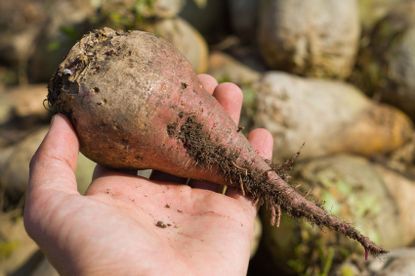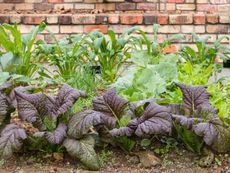Root Vegetable Storage: How To Store Root Crops In Sand


Every summer's end, at the peak of harvest time, many people find they have more produce than they can use, resulting in a flurry of activities attempting to can, dry, or freeze that which cannot be immediately put to use. You spent all summer nurturing your garden and you certainly don't want it to go to waste, but it can be exhausting trying to utilize every carrot, turnip, etc. There is another way-- sand storing root vegetables.
What is Sand Storing?
Did you know that the American household wastes more food per year than restaurants, groceries, and farms combined? A bountiful fall harvest, although a boon, may lead you to wonder about alternative root vegetable storage. Storing veggies in sand was mentioned above, but what is sand storing? Root vegetable storage, along with other crops such as apples, is not a new concept. Our forefathers, or mothers, used to store root veggies in a root cellar, often nestled in among sand. Using sand helps to regulate humidity, keeping excess moisture away from the vegetable so it doesn't rot and extending its shelf life. So, how do you store root crops in sand?
How to Store Root Crops in Sand
Storing root veggies in sand can be accomplished in a couple of simple ways. First of all, you can utilize your refrigerator's crisper drawer as a receptacle. Start with “play” sand-- the fine, washed type sand used to fill a child's sandbox. Fill the crisper with a few inches (8 cm.) of sand and tuck in root veggies such as turnips, carrots, beets or rutabagas, as well as any firm-fleshed fruits like apples or pears. Cover them with sand, leaving a bit of space between each so air can circulate. Fruit should be kept at least an inch (2.5 cm.) apart. Do not wash any produce that you are sand storing, as this would accelerate decomposition. Just brush off any dirt and remove any green portions such as carrot fronds or beet tops. You can also store produce in sand in a cardboard or wood box in a cool basement, pantry, cellar, shed, or even an unheated garage, provided the temperature doesn't drop below freezing. Just follow the same procedure as above. Veggies should be kept separate from apples, which give off ethylene gas and can hasten ripening, hence decomposition. Root veggies that grow vertically, such as carrots and parsnips, can be stored the same way, in an upright position within the sand. To truly extend the life of your root vegetables, it's a good idea to keep them in a dry place for a day or two so the skins can cure or dry prior to entombing them in sand. Potatoes, carrots, turnips, radishes, beet root, Jerusalem artichokes, onions, leeks, and shallots can all be sand stored with excellent results. They will keep for up to six months. Ginger and cauliflower will also sand store well. Some folks say that Napa cabbage, escarole, and celery can be stored using this method for a couple of months. If you have a surfeit of produce and your neighbors, friends, and family refuse to take any more, an experiment as to what other veggies may benefit from sand storing might be in order.
Gardening tips, videos, info and more delivered right to your inbox!
Sign up for the Gardening Know How newsletter today and receive a free download of our most popular eBook "How to Grow Delicious Tomatoes."

Amy Grant has been gardening for 30 years and writing for 15. A professional chef and caterer, Amy's area of expertise is culinary gardening.
-
 Urban Composting Guide: How To Compost In The Middle Of The City
Urban Composting Guide: How To Compost In The Middle Of The CityUrban composting does not have to be daunting. You can compost in the city, and maybe even try some urban worm composting!
By Mary Ellen Ellis
-
 Shrub Diseases And Pests To Watch Out For
Shrub Diseases And Pests To Watch Out ForShrub diseases and pests can be challenging. Learn how to recognize and eradicate them before they can present a danger to your plants.
By Susan Albert
-
 How Many Vegetables To Plant Per Person For A Year
How Many Vegetables To Plant Per Person For A YearGauging how much to plant in a vegetable garden can eliminate waste while still producing enough for your family. Click for more.
By Bonnie L. Grant
-
 13 Perennial Fruits And Vegetables You Only Have To Plant Once
13 Perennial Fruits And Vegetables You Only Have To Plant OnceLooking to set it and forget it? Find out which fruits and vegetables can be grown as perennials.
By Laura Miller
-
 11 Edible Plants For A Year-Round Garden In A Bucket
11 Edible Plants For A Year-Round Garden In A BucketWant to know how to grow food inside your house and which foods do best indoors? Click here to learn all about it.
By Bonnie L. Grant
-
 Frost Tolerance Of Vegetables From Least To Most Hardy
Frost Tolerance Of Vegetables From Least To Most HardyHow cold can vegetables tolerate? Knowing which veggies will survive frosts and freezes is essential for the success of your garden. Click here for more.
By Laura Miller
-
 Best Vegetables To Pickle Straight From The Garden
Best Vegetables To Pickle Straight From The GardenPickles aren’t limited to just cucumbers. Read on for tips on pickling your fresh veggies.
By Amy Grant
-
 Benefits Of Planting In Fall Vs. Spring Vegetable Plots
Benefits Of Planting In Fall Vs. Spring Vegetable PlotsLearn why some vegetables do better if you plant them in fall instead of spring.
By Laura Miller
-
 Interplanting Vegetables In The Fall Garden
Interplanting Vegetables In The Fall GardenLearn all about the benefits of interplanting vegetables for your fall garden.
By Laura Miller
-
 Best Vegetables For Growing In Perlite
Best Vegetables For Growing In PerlitePerlite is a natural growing medium that comes from super-heated volcanic glass. In some cases, it works better than soil. Read on for more info.
By Laura Miller